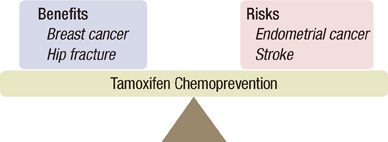J Breast Cancer.
2012 Mar;15(1):51-56. 10.4048/jbc.2012.15.1.51.
Estimating the Risks and Benefits of Tamoxifen for Prophylactic Breast Cancer Chemoprevention in Korea
- Affiliations
-
- 1Department of Surgery, Dankook University College of Medicine, Cheonan, Korea. changmc@dankook.ac.kr
- 2Department of Radiology, Dankook University College of Medicine, Cheonan, Korea.
- KMID: 2286473
- DOI: http://doi.org/10.4048/jbc.2012.15.1.51
Abstract
- PURPOSE
According to the National Surgical Adjuvant Breast and Bowel Project P1 (NSABP-P1) study, tamoxifen can prevent 49% of invasive breast cancers in patients who have a 5-year risk of 1.67% or more. Because tamoxifen is associated with both adverse effects (endometrial cancer, stroke, pulmonary embolism) and protective effect (fracture prevention), it is necessary to weigh the risks and benefits of using tamoxifen for prevention in Korean women. This study weighed those risks and benefits.
METHODS
Data were reviewed on the incidences of breast cancer, hip fracture, endometrial cancer and stroke in the absence of tamoxifen treatment in Korean women. We also reviewed NSABP-P1 data on the effects of tamoxifen on these outcomes. A risk-benefit index was calculated according to age and specific risk of breast cancer. Sensitivity analyses were performed with assumptions regarding the effects of tamoxifen.
RESULTS
Compared to U.S. women, the numbers of hip fractures and endometrial cancers were lower, but the number of strokes was much higher. The net benefit of tamoxifen was reduced with increasing age because of a high risk of stroke in older women. Older Korean women had more risk than benefit from tamoxifen chemoprevention. Only women younger than age 40 had a positive risk-benefit index with an average 5-year risk of breast cancer in Korea. Sensitivity analysis showed that this result was robust.
CONCLUSION
Women under the age 40 had more benefit than risk from tamoxifen chemoprevention. Tamoxifen chemoprevention should be limited to Korean women younger than age 40.
Keyword
MeSH Terms
Figure
Cited by 1 articles
-
Validation of Risk Assessment Models for Predicting the Incidence of Breast Cancer in Korean Women
Jun Won Min, Myung-Chul Chang, Hae Kyung Lee, Min Hee Hur, Dong-Young Noh, Jung Han Yoon, Yongsik Jung, Jung-Hyun Yang,
J Breast Cancer. 2014;17(3):226-235. doi: 10.4048/jbc.2014.17.3.226.
Reference
-
1. Fisher B, Costantino JP, Wickerham DL, Redmond CK, Kavanah M, Cronin WM, et al. Tamoxifen for prevention of breast cancer: report of the National Surgical Adjuvant Breast and Bowel Project P-1 Study. J Natl Cancer Inst. 1998. 90:1371–1388.
Article2. Gail MH, Costantino JP, Bryant J, Croyle R, Freedman L, Helzlsouer K, et al. Weighing the risks and benefits of tamoxifen treatment for preventing breast cancer. J Natl Cancer Inst. 1999. 91:1829–1846.
Article3. Kim SH, Chae YS, Son WJ, Shin DJ, Kim YM, Chang MC. Estimation of individualized probabilities of developing breast cancer for Korean women. J Korean Surg Soc. 2008. 74:405–411.4. Kang HY, Yang KH, Kim YN, Moon SH, Choi WJ, Kang DR, et al. Incidence and mortality of hip fracture among the elderly population in South Korea: a population-based study using the national health insurance claims data. BMC Public Health. 2010. 10:230.
Article5. Jee SH, Park JW, Lee SY, Nam BH, Ryu HG, Kim SY, et al. Stroke risk prediction model: a risk profile from the Korean study. Atherosclerosis. 2008. 197:318–325.
Article6. Ministry for Health, Welfare and Family Affairs, Korea Central Cancer Registry. Cancer Incidence in Korea 1999-2002. 2008. Goyang: Korea Central Cancer Registry;76–77.7. Statistics of deaths by cause. Korean Statistical Information Service. Accessed August 1st, 2011. http://www.kosis.kr/.8. Freedman AN, Graubard BI, Rao SR, McCaskill-Stevens W, Ballard-Barbash R, Gail MH. Estimates of the number of US women who could benefit from tamoxifen for breast cancer chemoprevention. J Natl Cancer Inst. 2003. 95:526–532.
Article9. Waters EA, Cronin KA, Graubard BI, Han PK, Freedman AN. Prevalence of tamoxifen use for breast cancer chemoprevention among U.S. women. Cancer Epidemiol Biomarkers Prev. 2010. 19:443–446.
Article10. Choi WI, Lee MY, Oh D, Rho BH, Hales CA. Estimated incidence of acute pulmonary embolism in a Korean hospital. Clin Appl Thromb Hemost. 2011. 17:297–301.
Article
- Full Text Links
- Actions
-
Cited
- CITED
-
- Close
- Share
- Similar articles
-
- Tamoxifen Resistance and Crosstalk of Signal Transduction in Breast Cancer
- Two Cases of Endometrial Adenocarcinoma Associated with Tamoxifen Use
- Practice Patterns of Surgeons for the Management of Hereditary Breast Cancer in Korea
- Usage Patterns of Surveillance, Chemoprevention and Risk-Reducing Surgery in Korean BRCA Mutation Carriers: 5 Years of Experience at a Single Institution
- Two Cases of Endometrial Carcinoma in Tamoxifen-treated Breast Cancer Patients in Korea



